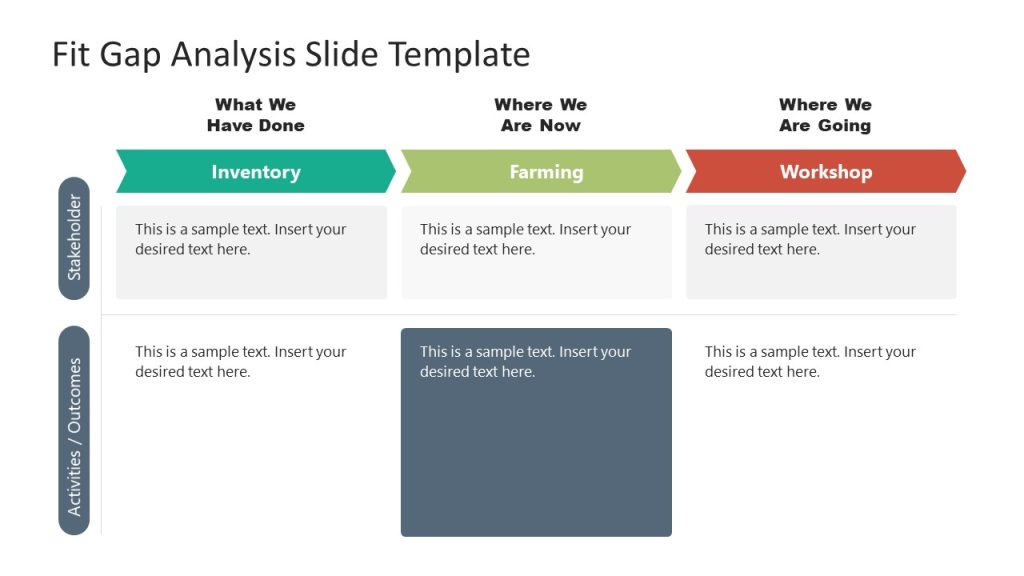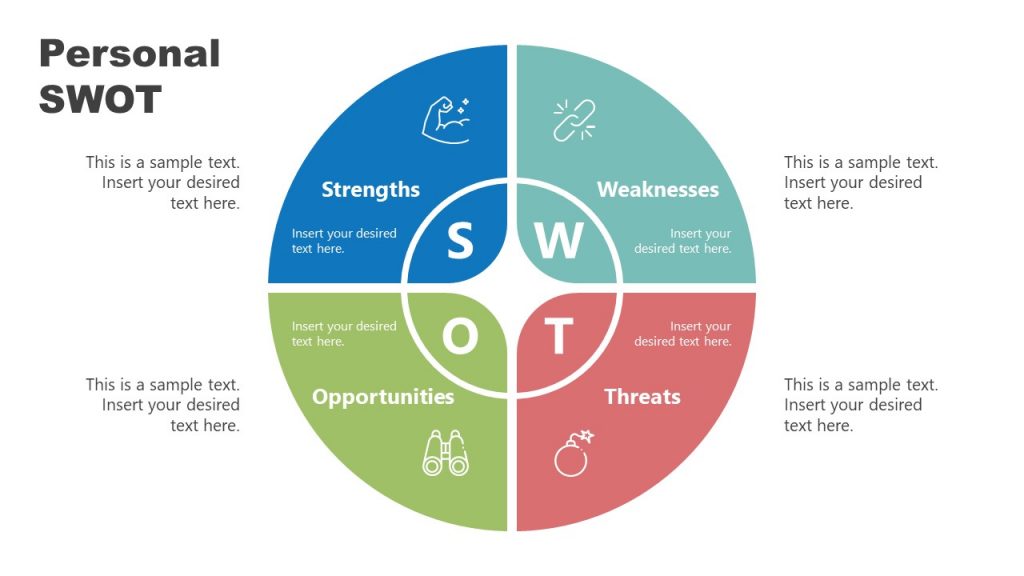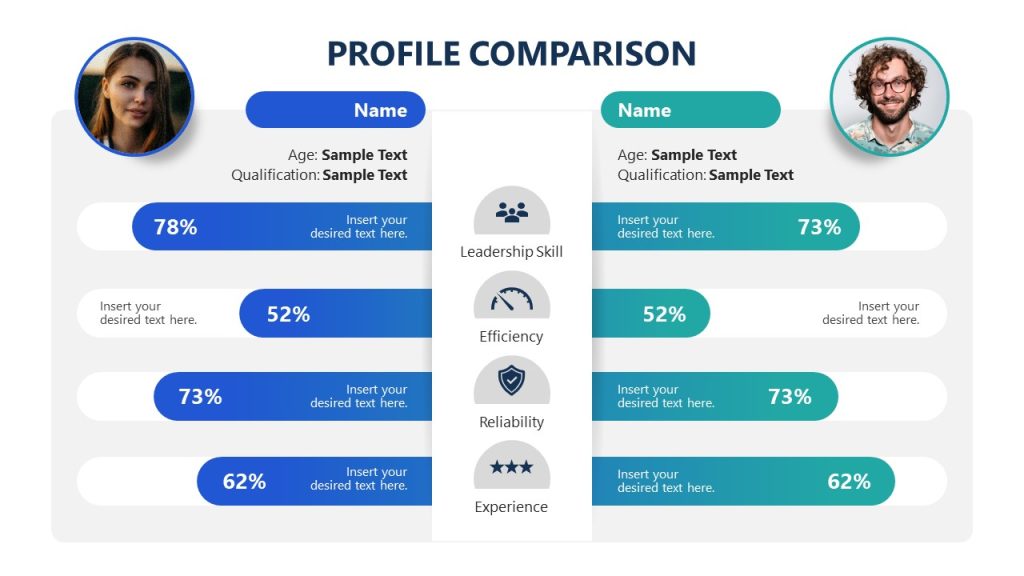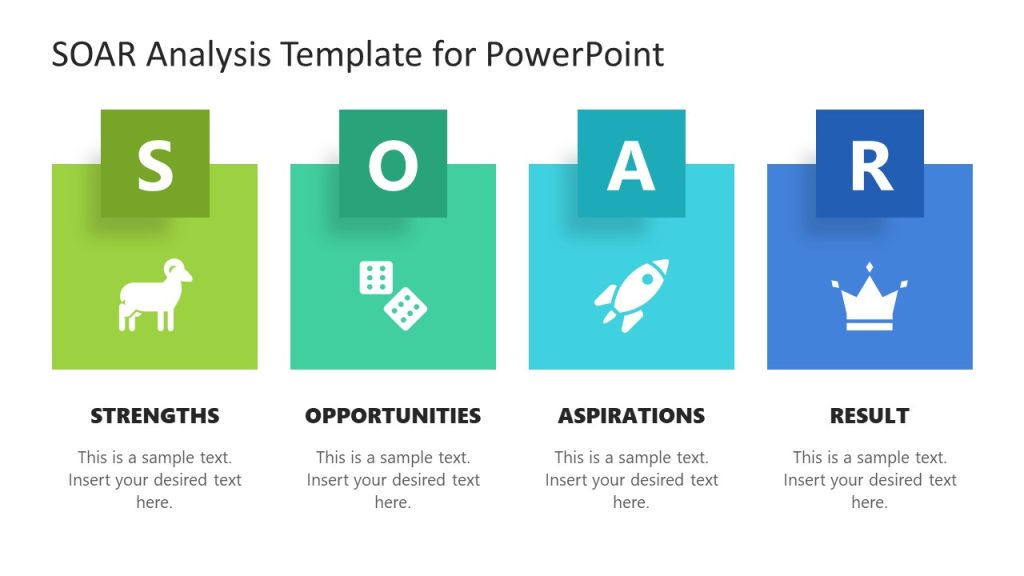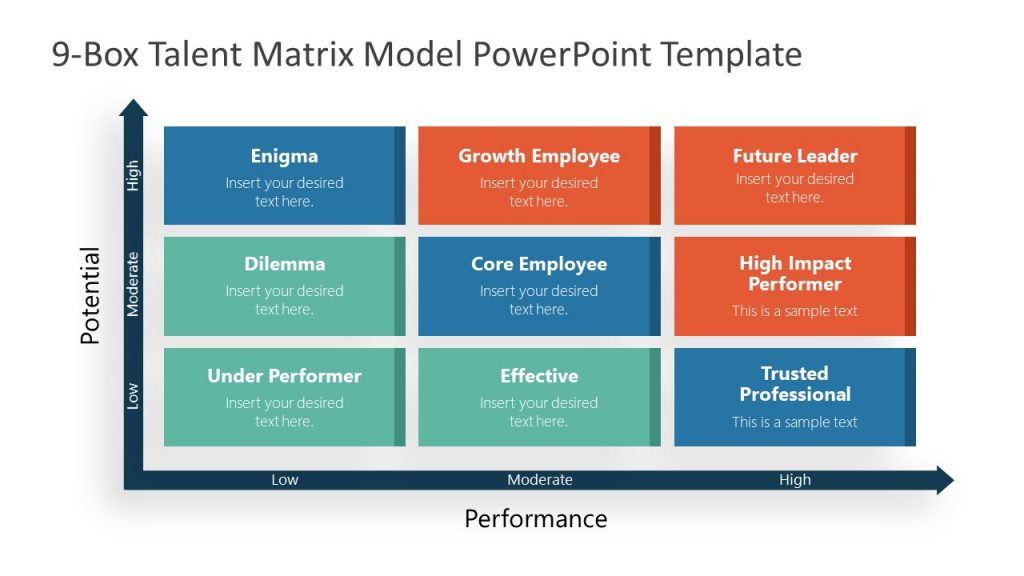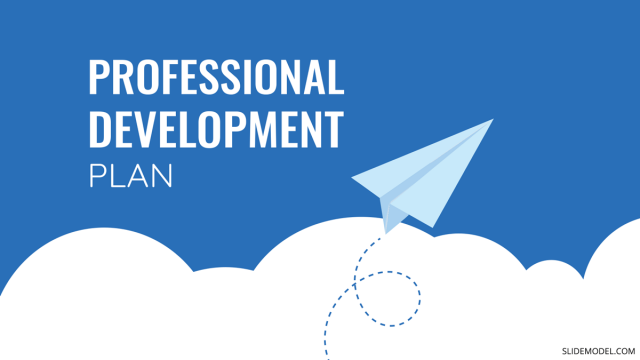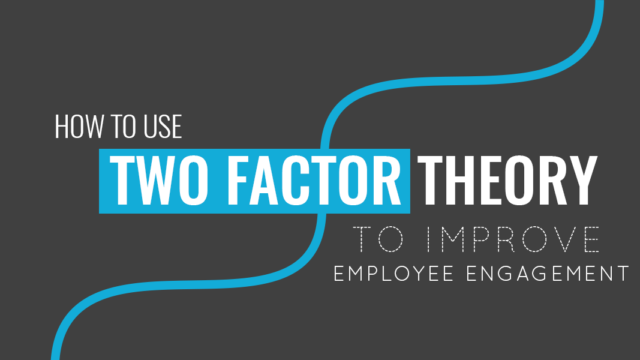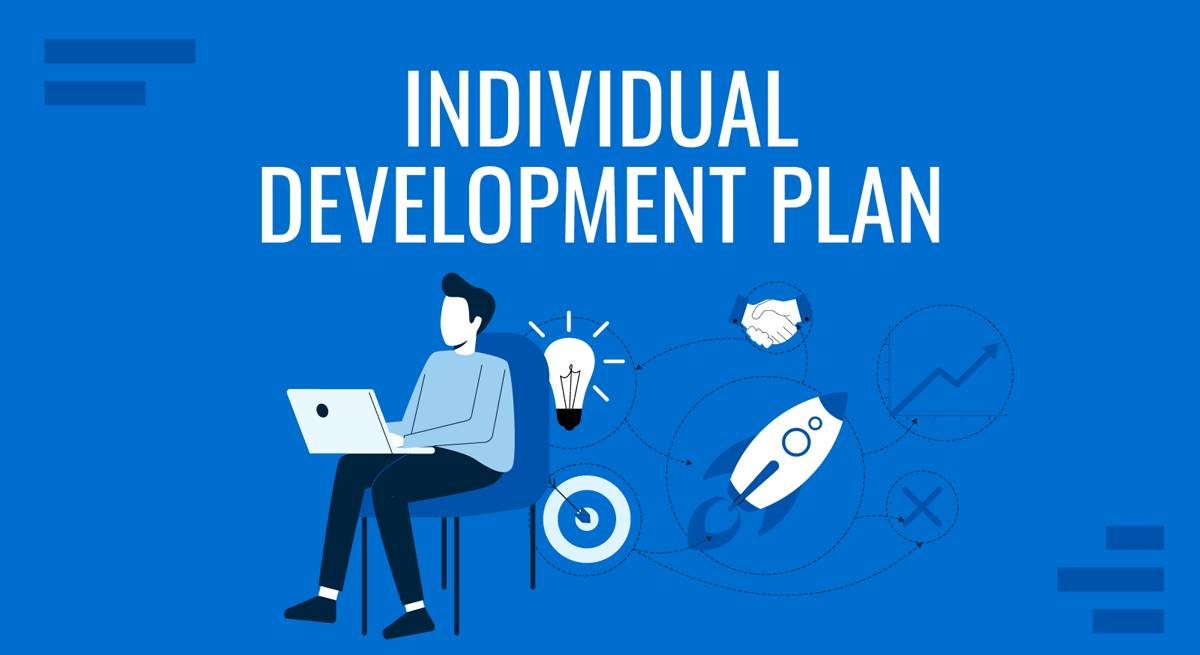
The average global attrition rate is consistently rising as the Great Resignation, a trend that started in 2021, encourages talent not to settle for anything less. In the US alone, more than 50 million workers quit their jobs in 2022, breaking the record set the year prior. This left many companies grappling with numerous challenges of losing valuable talent and the subsequent need to fill vacant positions.
Although employee churn is a natural part of the employment cycle, there are strategies that organizations can implement to keep it at a minimum. Some companies turn to the easy route of increasing wages to keep up with the competition of acquiring good talent. But, more than money is needed to keep your employees engaged and loyal to you.
In reality, many workers quit because they don’t feel there’s an opportunity for career advancement in their current organization. Recognizing this, businesses must explore alternative approaches to attract and retain talent, focusing on fostering professional growth and development.
One strategy organizations can leverage to address the aspirations of their employees and mitigate the impact of high employee churn rates is the implementation of individual development plans (IDPs).
Table of Contents
- What is an Individual Development Plan
- The Benefits of an Individual Development Plan
- Steps to Creating and Implementing IDPs
- Individual Development Plan Example
- Helpful Templates when Presenting an IDP
- Overcoming Challenges in Implementing IDP
- Conclusion
What is an Individual Development Plan
An individual development plan (IDP) is a structured framework that serves as a roadmap for enhancing skills, acquiring knowledge, and unlocking opportunities for advancement within the organization. This proactive approach ensures that employees are equipped with the necessary tools and resources to progress in their careers.
Preparing this document is typically a collaborative effort between the employee and their supervisor or manager. The employee takes the lead in identifying their career aspirations, assessing their current skills and competencies, and determining areas for improvement. Managers take a supportive role, providing guidance and feedback to help the employees in their development journey.
Many companies require their employees to complete an IDP, annually. The initial discussion of IDP typically happens between a manager and the employee during the annual evaluation, albeit not intended to be a performance evaluation tool. While it may touch upon performance-related aspects, its main focus is on the employee’s professional growth and development.
The Benefits of an Individual Development Plan
Promote Self-awareness and Goal-Setting
As employees create their IDP, they are prompted to assess their current skillset, knowledge, and competencies. More importantly, the IDP prompts employees to think critically about where they want to take their careers in the future.
Targeted Skill Development and Increased Competency
IDPs enable companies to align employee development with the specific skills and competencies required for their roles and organizational objectives. When employers know their employees’ learning needs, they can provide the necessary support to fill the skill gaps. This increase in competence leads to higher productivity and efficiency in their work as they become better equipped to handle their responsibilities and deliver high-quality results.
Foster Career Advancement Opportunities
Finding high-quality talents is challenging as the number of open jobs outnumbers job seekers. IDPs help identify and nurture high-potential employees for future leadership roles. By supporting their growth, a product development company can build a strong talent pipeline and ensure a smooth transition to key positions.
Improve Employee Retention
When employees clearly understand how their individual development contributes to the organization’s success – and feel appreciated for it – they become more motivated and focused. Through IDPs, employers can clearly communicate how they are willing to invest in their employees’ journey toward career development and, in return, convince them to stay in the company.
Steps to Creating and Implementing IDPs
Self-assessment and Identification of Strengths and Weaknesses
Self-assessment is the initial stage of an individual development plan (IDP) process. This step allows individuals to understand their current skill set and areas for improvement clearly. By assessing themselves, employees can identify their strengths to leverage and weaknesses to address in the development planning process.
At this stage, employees may be asked to develop a personal SWOT analysis – short for strengths, weaknesses, opportunities, and threats. This activity requires honesty with oneself, recognizing the areas they do best and where they face challenges. This will also document their action plans and the factors they think will affect their future performance.
Identification of Short-term and Long-term Career Goals
Where do you see yourself in x years? Applicants frequently encounter this question during interviews, which is also important in creating an IDP. This question helps individuals establish a long-term vision and set goals that align with their career aspirations.
Based on their self-assessment, employees must set goals that build on their current skills and address their weaknesses. For example, goals might include reaching a certain position, obtaining specific certifications or qualifications, or developing expertise in a particular area.
Long-term goals should be broken down into smaller milestones that employees can work towards within the timeframe of the IDP. This allows better progress tracking and ensures that development efforts are manageable and actionable.
Development of an Action Plan and Timeline
After employees have identified their desired destinations in their career journey, the next agenda is to determine how they plan to get there. This step involves outlining the specific steps and activities they will or want to undertake to achieve their goals, along with a timeline for completing them.
The steps should be logical to ensure effective progression. Consider dependencies between tasks and prioritize those critical for achieving the set goals.
Identification of Resources and Support Systems
At this stage, managers and employees should collaborate to identify the resources the company can provide to execute the action plan for their development. This may include various tools, materials, people, and even financial support that will help acquire or enhance a particular skill. Companies may explore a combination of internal and external resources to provide a diverse range of perspectives and learning opportunities for employees.
Regular Review and Updating of the IDP
Employees, with the help of their managers, should revisit their IDP periodically, review their progress, and make necessary modifications to adapt their goals to changing circumstances. It would be helpful to record their achievements and the steps they have taken to develop their skills. This will provide concrete evidence of their growth and gauge the effectiveness of their development strategies.
Valuable feedback may also arise during the review process, offering suggestions for new development opportunities or providing advice on overcoming obstacles.
Individual Development Plan Example
Let’s put the above steps into action, shall we? Let’s use a fictional employee named John, a digital marketing assistant who wants to expand his experience into the IT industry and technical marketing. John contacts his supervisor, who recommends he to reach out the continuous education office after checking his IDP.
Here’s what John’s development plan may look like.
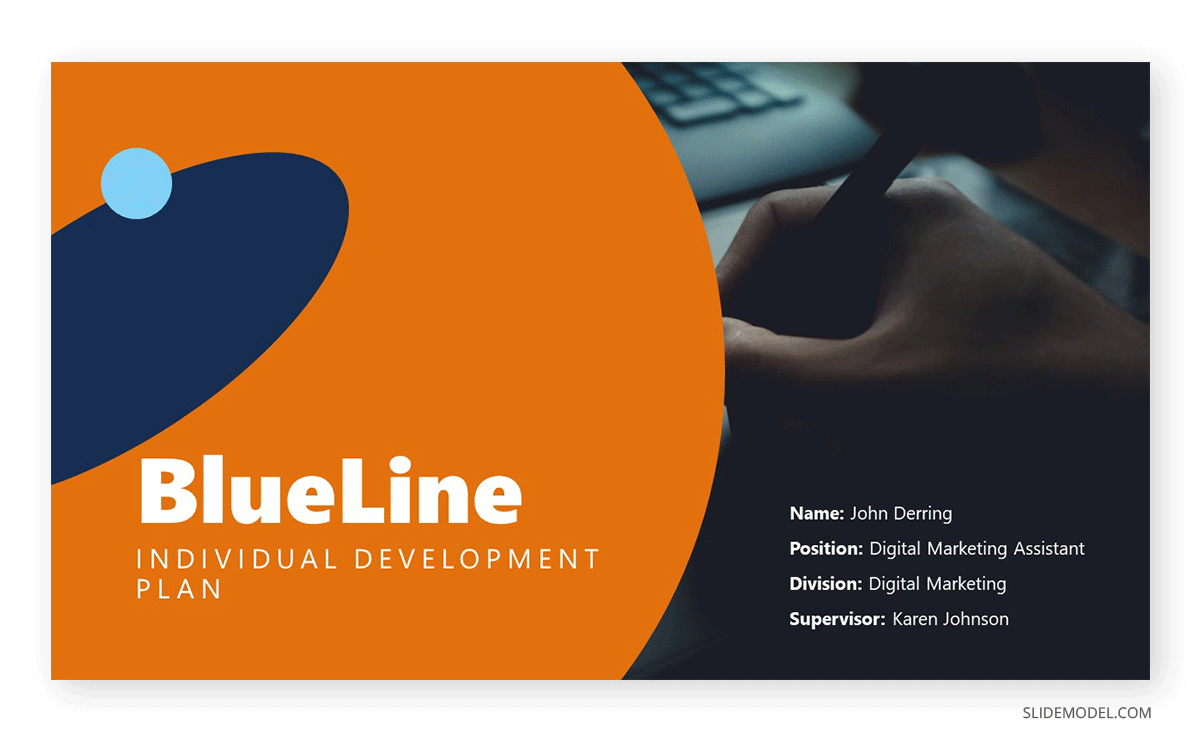
This first slide mentions the company name, full name and position of the employee, the department in which he works, and the supervisor’s name. The second slide attended the Skills Assessment when the IDP was built (hence the importance of keeping this document updated).
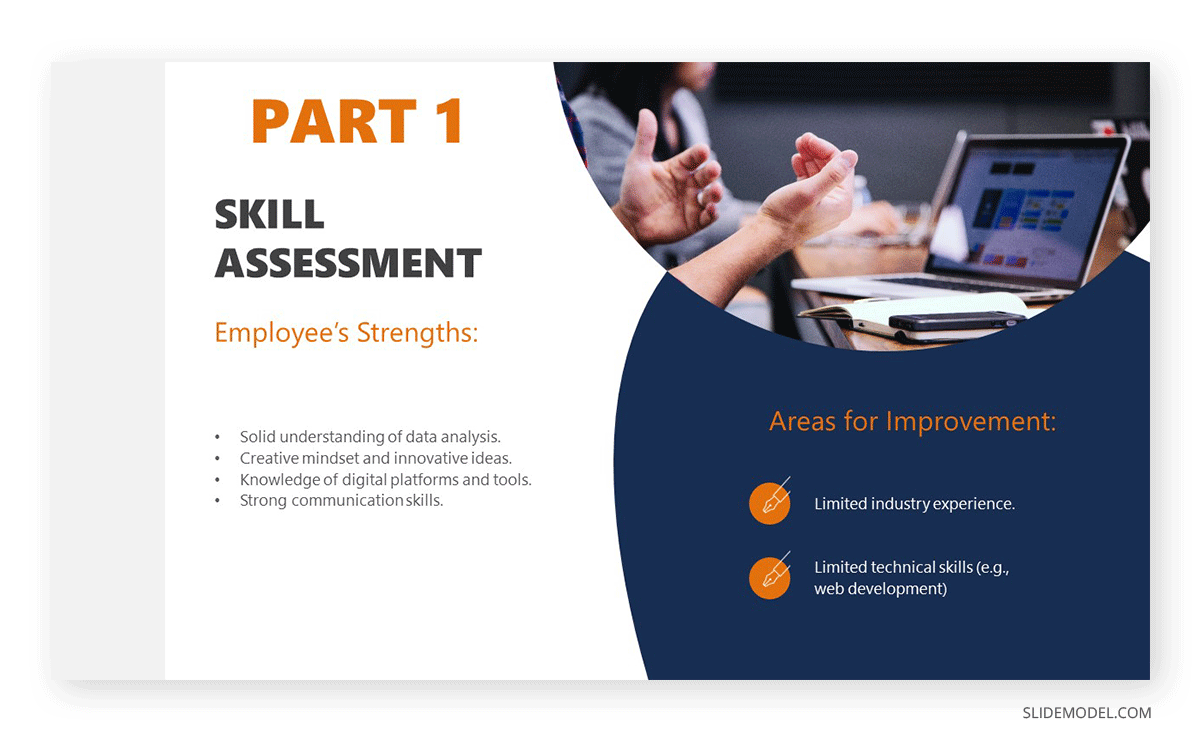
This third slide will answer the development goals and the mentors that shall guide the employee to accomplish them.
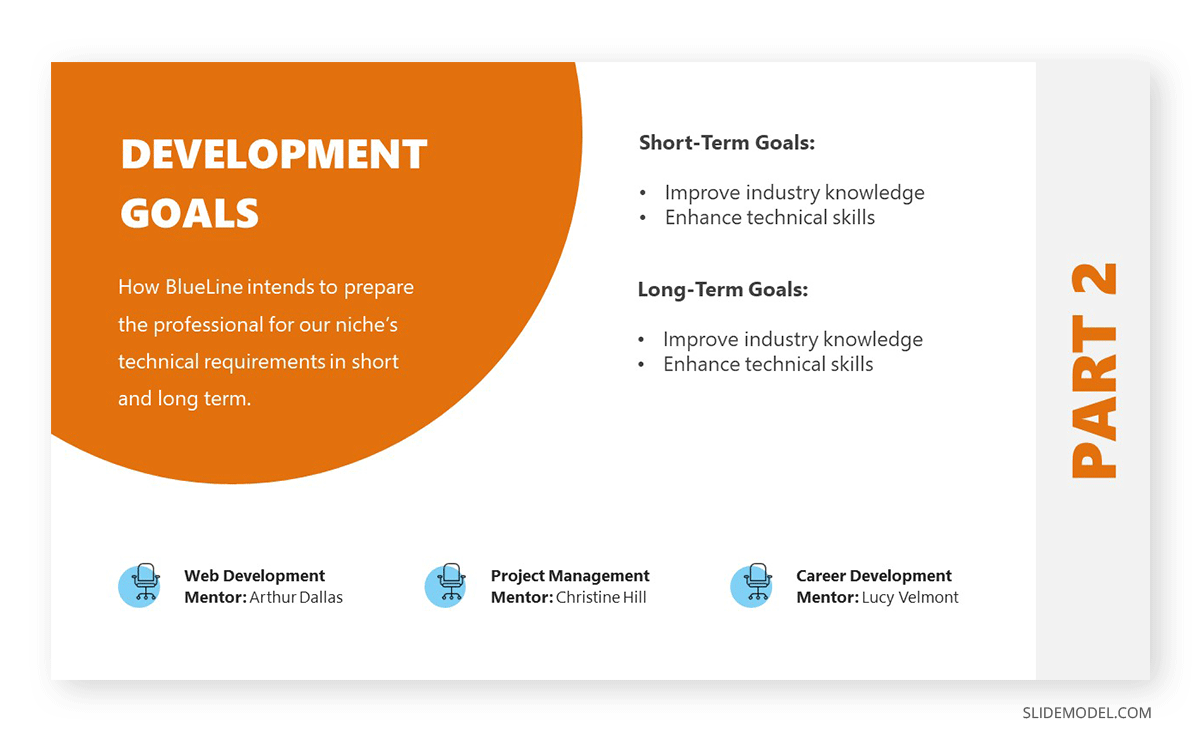
After establishing the areas in which the employee seeks professional growth, it is time to build the action plan, which should include the timeframe in which actions must happen and the assessment method to guarantee the acquisition of skills.
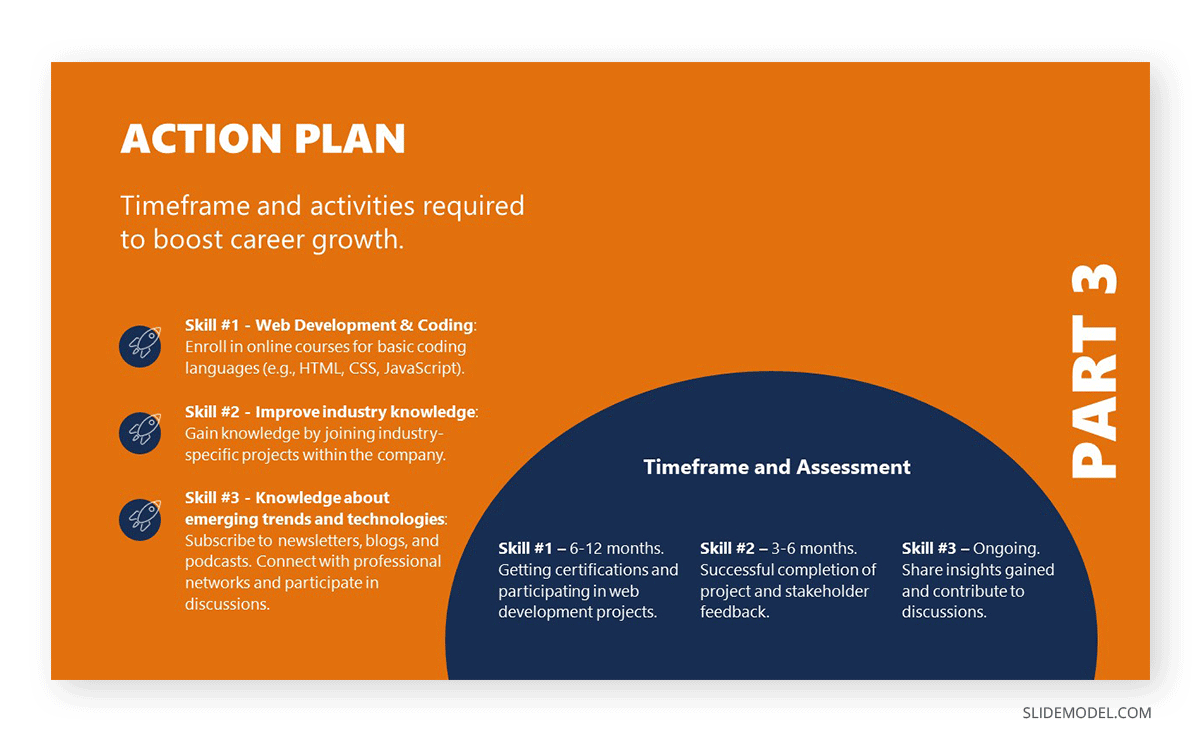
Helpful Templates When Presenting an IDP
Some organizations may prefer or require employees to use PowerPoint to present their individual development plans. In this case, presenters can create slides outlining their development goals, strategies, timelines, and other relevant information. Here are some PowerPoint templates that can enhance the clarity of IDP presentations.
SWOT PowerPoint Templates
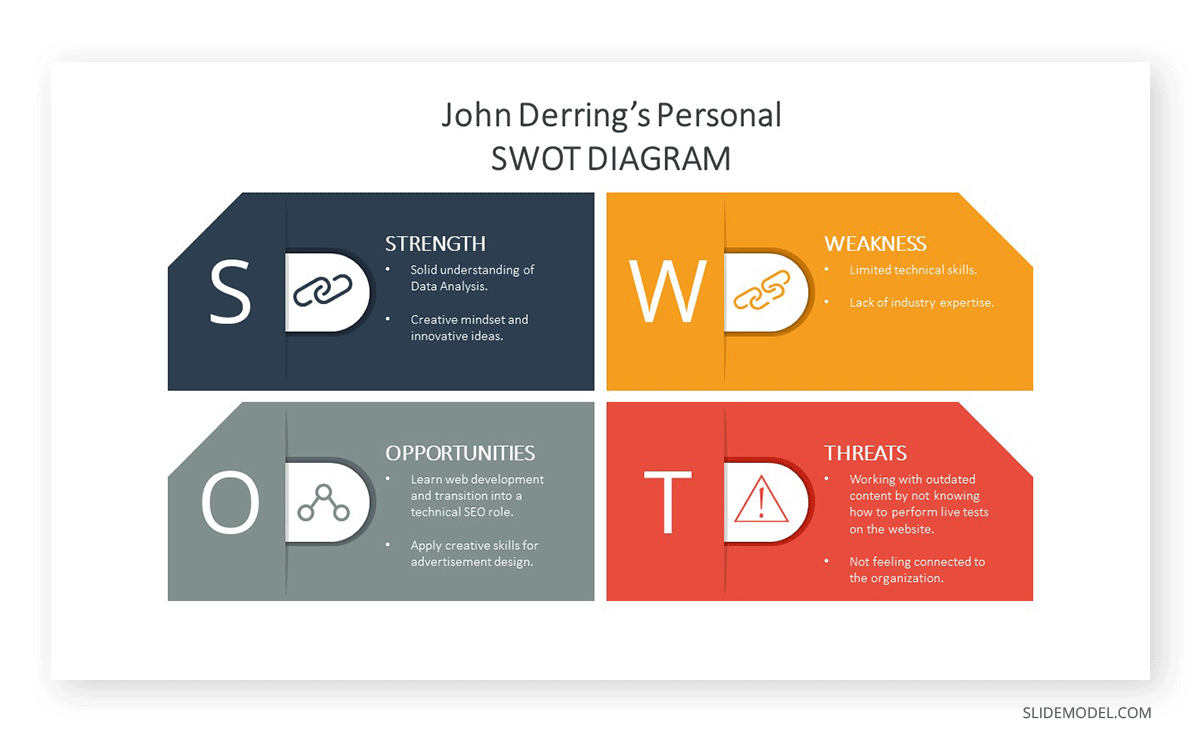
Employees may use SWOT analysis templates in this process to clearly communicate their aspirations to the managers. It is a simple structured planning approach to evaluate Strengths, Weaknesses, Opportunities, and Threats involved in career development. Employees and managers can use this template to align their understanding of the learning needs and efforts toward common goals.
In the case shown above, John Derring’s SWOT Diagram reflects his situation in approaching the IDP assessment.
Skills Assessment Matrix
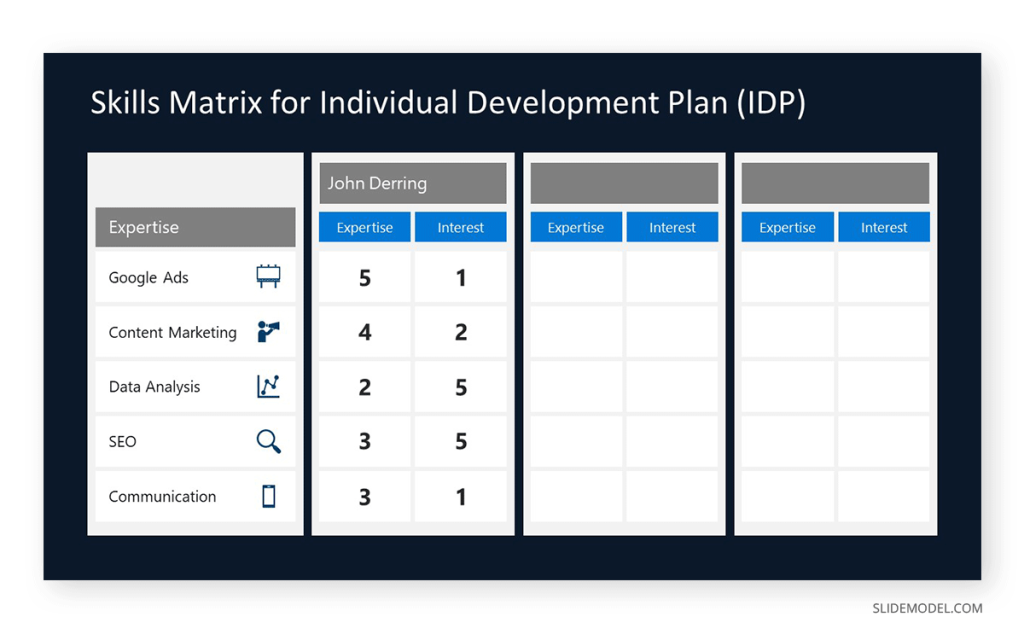
Skill Matrix is a tool managers use to assess and visualize employees’ skill levels and proficiencies. It is also a valuable tool to present skill gaps to address in IDPs and plan for personalized skill development for individuals.
For our case study, the Skills Matrix was used as a personal scorecard for John, allowing for two extra iterations throughout the course of the IDP action plan’s duration. This practice allows to refine the areas of interest over the course of an action plan, giving flexibility to the employee to tailor their skills. If multiple employees are subject to the same IDP, they can be compared using the same Skills Matrix template.
North Star Slide Template
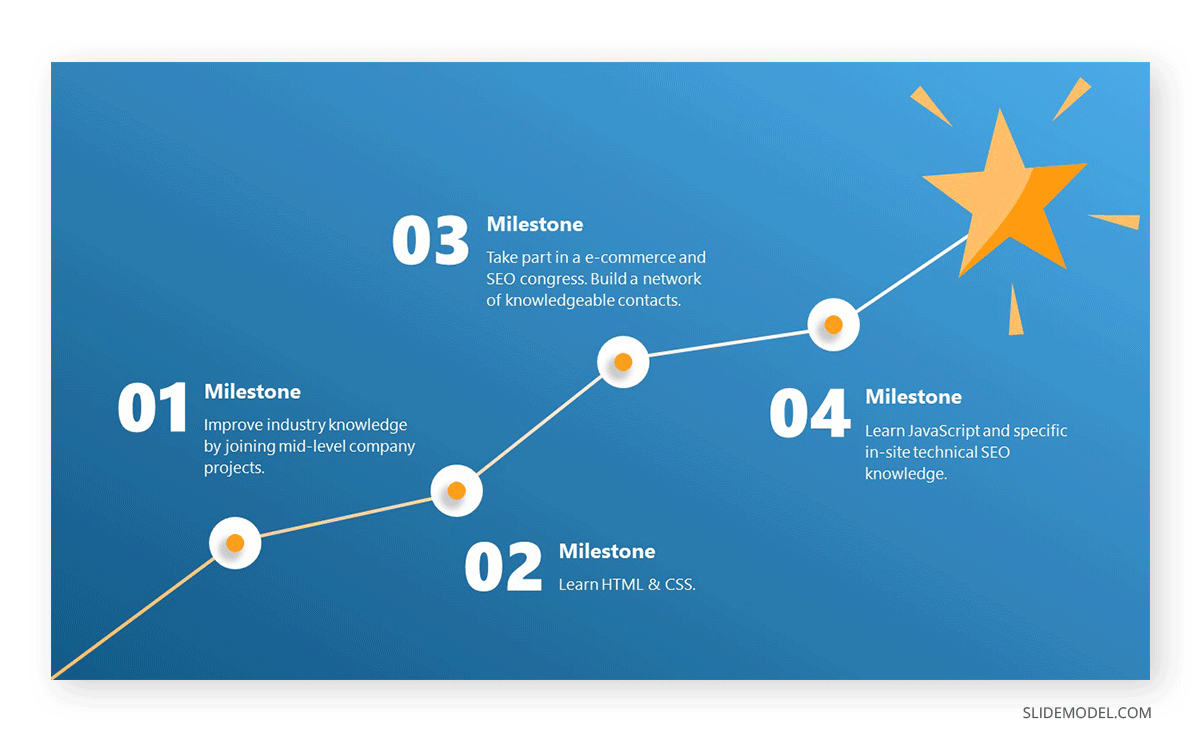
Businesses typically use the North Star slide template to outline the strategic objectives and key results they want to achieve. Similarly, employees can utilize this timeline template when presenting their career goals within an Individual Development Plan (IDP). This will help them visualize every milestone to achieve and how they will tackle the steps toward their overarching goal.
Overcoming Challenges in Implementing IDP
Resistance to Change
Some employees may take IDPs negatively and see them as additional work or obligations that could increase their workload or disrupt their existing routines. There is a natural tendency for individuals to be hesitant to embrace change, which hinders their advance in the career ladder.
Solution: Companies should tailor IDPs to the unique aspirations of employees and communicate to them its benefits through a dialogue. Recognizing their big and small achievements will also go a long way. When possible, reward their progress to motivate them to continue their efforts toward working on their IDP.
Lack of Support and Resources
Employees may hesitate to embrace IDPs when they feel a lack of support comes from the company itself. A lack of confidence in an organization’s commitment to employee development doesn’t happen overnight, though. They might have experienced previous development initiatives that were not effectively implemented.
Solution: Ensure adequate resources, such as budget, time, and personnel, are allocated to support employee development. Encourage managers to foster a knowledge-sharing culture and provide ongoing feedback on employees’ development progress.
Difficulty in Balancing Work and Personal Commitments
Time constraint is a significant barrier to achieving the development goals of employees. If employees are caught between fulfilling their IDPs and work responsibilities, they may lose motivation and even strain their work performance.
Solution: Organizations should foster a supportive culture that recognizes the importance of work-life balance. Managers may help team members identify which development goals to prioritize that align with the company’s growth opportunities. Organizations may also explore flexible work arrangements to allow employees to balance their work and development goals better.
FAQs
Why are Individual Development Plans important?
IDPs are vital for promoting employee engagement, self-awareness, and career progression. They help organizations retain top talent, foster leadership pipelines, and align employee development with business objectives, ultimately improving organizational performance.
What are the benefits of an IDP for employees and organizations?
– For Employees: Promotes self-awareness, clarifies career goals, and enables skill enhancement for personal growth.
– For Organizations: Improves employee retention, builds a leadership pipeline, boosts productivity, and ensures alignment between individual and organizational goals.
What tools or templates are useful when creating an IDP?
– SWOT Analysis Templates: Helps employees evaluate strengths, weaknesses, opportunities, and threats.
– Skills Matrix Templates: Visualizes skill levels and identifies gaps.
– North Star Templates: Outlines career milestones and goals.
– Action Plan Templates: Details steps, timelines, and assessment methods for achieving development goals.
How does self-assessment contribute to the IDP process?
Self-assessment helps employees identify their current skills, strengths, and areas for improvement. This process is essential for setting realistic and meaningful development goals aligned with career aspirations.
How often should an IDP be reviewed?
IDPs should be reviewed periodically, typically during annual evaluations or at agreed intervals. Regular reviews ensure the plan remains relevant, tracks progress, and adapts to changing circumstances or goals.
How does an IDP differ from performance evaluations?
IDPs focus on professional growth and career development, emphasizing skill enhancement and future aspirations. In contrast, performance evaluations assess past work performance and achievements.
Conclusion
The current high employee churn rate necessitates that companies think outside the box and adopt innovative strategies to keep a solid workforce. Instead of traditional approaches, such as increasing wages, organizations should create a work environment that fosters employee engagement and growth.
Employees are the backbone of organizations, and their growth and professional development are directly linked to the success and sustainability of the company. Prioritizing employee development through initiatives like Individual Development Plans (IDPs) attracts and retains top talent and boosts overall organizational performance.


